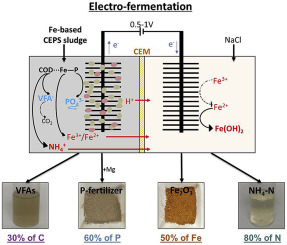Water Research ( IF 11.4 ) Pub Date : 2019-03-28 , DOI: 10.1016/j.watres.2019.03.075
Lin Lin , Long-hang Tam , Xue Xia , Xiao-yan Li

|
Iron (Fe)-based chemically enhanced primary sedimentation (CEPS) is an effective process used to remove organic and phosphorus (P) pollutants from wastewater into sludge. In this study, electro-fermentation (EF) technology was developed to treat the organic- and P-rich Fe-sludge for the purposes of sludge reduction and resource recovery. Using a two-chamber bioreactor with a cation exchange membrane and an exterior voltage (0.5–1.0 V) for sludge treatment, the EF system enabled product accumulation and separation during the fermentation process. Compared with the conventional fermentation in a single-chamber reactor, the EF treatment of Fe-sludge significantly improved the efficiency of P dissolution from the sludge from 8% to 56% after 4 d. Meanwhile, about 70% of released ammonium ions and 50% of Fe in the sludge were driven by the current from the sludge suspension into the cathode chamber for potential recovery. With a similar yield of volatile fatty acids (VFAs) but less ammonium remaining, the CODVFA/NNH4 of the sludge supernatant from the EF reactor could reach 67.7, much higher than that from the single-chamber fermenter at 13.0. The protease activity was effectively promoted by the EF treatment, suggesting that both electrochemical and biological hydrolysis effects contributed to the increased P release from the sludge. Microbial community analysis showed that the electrical stimulation increased the relative abundance of Firmicutes and facilitated the growth of Acidobacteria. Overall, electro-fermentation was developed as an effective biotechnology for processing Fe-based CEPS sludge with the benefits of recovering organics, phosphorus, ammonium and iron resources.
中文翻译:

两室生物反应器中铁强化的初沉污泥的电发酵,用于产物分离和资源回收
基于铁(Fe)的化学增强初沉(CEPS)是一种有效的工艺,用于将废水中的有机和磷(P)污染物去除为污泥。在这项研究中,为了减少污泥和回收资源,开发了电发酵(EF)技术来处理富含有机和P的铁污泥。EF系统使用带有阳离子交换膜和外部电压(0.5–1.0 V)的两室生物反应器进行污泥处理,从而在发酵过程中实现了产物的积累和分离。与单室反应器中的常规发酵相比,EF处理的Fe-污泥在4 d后将P从污泥中的溶解效率从8%显着提高到56%。同时,污泥中约70%的释放的铵离子和50%的Fe受污泥悬浮液进入阴极室的电流驱动,以进行电势回收。挥发性脂肪酸(VFA)的收率相近,但铵盐残留量少,因此CODEF反应器的污泥上清液的VFA / N NH4可以达到67.7,远高于单腔发酵罐的13.0。EF处理有效地促进了蛋白酶的活性,这表明电化学和生物水解作用都促进了污泥中P的释放。微生物群落分析表明,电刺激增加了Firmicutes的相对丰度,并促进了酸性菌的生长。总体而言,电发酵技术是一种有效的生物技术,用于处理铁基CEPS污泥,具有回收有机物,磷,铵和铁资源的优势。































 京公网安备 11010802027423号
京公网安备 11010802027423号